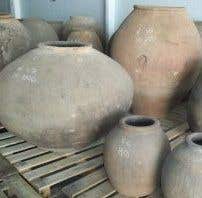From £9.50, €15.95, 10,920 Chilean pesos, $23.99, Ca$24.99, 95 Brazilian Reals
This is the most extraordinary wine – extraordinary in a very good way indeed. It's made from the delicate Cinsault grapes grown on bushvines in the far south of Chile 400 km south of the capital Santiago that have been fermented and aged in centenarian clay jars, the tinajas for which Valdepeñas, for example, was once famous. De Martino, one of the most dynamic and enterprising of Chile's many enterprising and experimental companies, say they are reviving an ancient tradition with this unusual winemaking technique – though thanks to the increasing prevalence of amphorae and eggs in wineries all over the world, it is becoming more and more familiar.
in centenarian clay jars, the tinajas for which Valdepeñas, for example, was once famous. De Martino, one of the most dynamic and enterprising of Chile's many enterprising and experimental companies, say they are reviving an ancient tradition with this unusual winemaking technique – though thanks to the increasing prevalence of amphorae and eggs in wineries all over the world, it is becoming more and more familiar.
What bewitched me about the wine was nothing to do with the winemaking detail (though I must confess to a penchant for well-vinified Cinsault) but the taste of the wine itself. Pale purple, it's so fresh and pure that it washes over the palate like the gentlest of waves, I felt. Obviously in an impressionist mood that day. I gave a case to my literary agent and he's in love with it too. It's the sort of summer red that would be delighted to be served cool, and has no tough tannin so could be drunk without food as well as with fish.
I'd guess by the vintage that it has been designed for early drinking but I wouldn't panic – in fact I'd be curious – if I still had some around in two or three years' time.
It's imported into the UK by Caves de Pyrène, whose Doug Wregg provides the notes below*, but it would be much more sensible (and cheaper) to buy it from retailers The Wine Society, WineBear or New Street Wines.
My tasting took place at the end of a Caves de Pyrène tasting, the second big professional tasting of the day. Unbeknown to me, Julia recently had the chance to taste it at her leisure at home and was equally impressed. Here's her (much more eloquent, as usual) note:
'Pale crimson. Wild, sour-cherry aroma, wild herbs, just slightly earthy. Lovely delicacy and fine dry tannins. Naturally refined and delicate rather than cleverly polished but still a wine for quaffing and early drinking. Firm, slightly earthy finish. Underlying concentration shows more in length than in any demonstration of power. Light, scented and complex and delicious very slightly chilled.'
According to dear old wine-searcher.com, it is also currently available in Holland, the US (Chambers Street Wines of New York), British Columbia, Brazil and – surprise, surprise, Chile. You can also order direct from De Martino's website.
See my other Cinsault wines of the week from California, South Africa and the Languedoc, and our recently published collected tasting notes on 126 wines from both North and South America, including this absolute bargain.
*Douglas Wregg of Les Caves de Pyrène: This wine rescues an old tradition deeply rooted in rural Chile: winemaking using large earthenware jars called tinajas. Once upon a time many farms used to make wine for their own consumption which they ferment and store in amphorae of various shapes and sizes. The commercialisation of the Chilean wine industry has seen this tradition disappear, but a couple of years ago, the De Martino family decided to revive it and purchased as many clay pots as they could find including former ashtrays and holders of cactus plants!
 This accords with De Martino's desire to row back from the throw-the-kitchen-sink-at-it winemaking style towards a more natural, nuanced approach involving respect for terroir and vintage. De Martino have converted most of their vineyards to organic viticulture; they now use natural yeasts in the winemaking, and from 2011 eliminated all new oak from their winemaking practices – a huge departure for a relatively commercial Chilean winery.
This accords with De Martino's desire to row back from the throw-the-kitchen-sink-at-it winemaking style towards a more natural, nuanced approach involving respect for terroir and vintage. De Martino have converted most of their vineyards to organic viticulture; they now use natural yeasts in the winemaking, and from 2011 eliminated all new oak from their winemaking practices – a huge departure for a relatively commercial Chilean winery.
Viejas Tinajas has been fermented and aged as naturally as possible in amphorae over 100 years old, without intervention and in search of a faithful reflection of its origin. An old, unirrigated vineyard in the heart of the Coastal Mountain Range in the Itata Valley gives life to this wine, some 400 kilometres to the south of Santiago and just 22 kilometres from the Pacific Ocean. Consider this: Cinsault, old bush vines (35 hl/ha yields), on granitic soils, farmed with horses, whole berries, no punch down, gentle pressing. In the winter the malolactic is ready. The wine is not filtered or fined and there is no added sulphur. No pumps are used with the tinajas, only good old-fashioned sucking.

